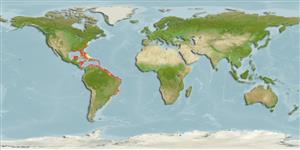Common names from other countries
>
Carangaria/misc (Various families in series Carangaria) >
Polynemidae (Threadfins)
Etymology: Polydactylus: Greek, poly = a lot of + greek, daktylos = finger (Ref. 45335).
More on author: Linnaeus.
Environment: milieu / climate zone / depth range / distribution range
Ecologia
marinhas; estuarina demersal; intervalo de profundidade 0 - 55 m (Ref. 26912). Tropical; 41°N - 14°S, 93°W - 35°W (Ref. 57343)
Western Atlantic: New Jersey, USA to Salvador, Brazil. Reported to range to Uruguay (Ref. 9626). Not occurring in the northern and western Gulf of Mexico.
Tamanho / Peso / Idade
Maturity: Lm ? range ? - ? cm
Max length : 33.0 cm TL macho/indeterminado; (Ref. 57343); common length : 20.0 cm TL macho/indeterminado; (Ref. 3796)
Espinhos dorsais (total) : 8 - 9; Raios dorsais moles (total) : 11; Espinhos anais: 3; Raios anais moles: 12 - 14.
Found on sandy and muddy bottoms of coastal waters, estuaries and mangroves, and occasionally in the surf (Ref. 57343). Young aggregate near river mouths (Ref. 57343). Common around islands (Ref. 9710). Nocturnal feeder, taking crustaceans, chaetognaths, plant material, and polychaetes (Ref. 57343). May have a prolonged spawning season (Ref. 57343).
Life cycle and mating behavior
Maturities | Reprodução | Spawnings | Egg(s) | Fecundities | Larvas
Motomura, H., 2004. Threadfins of the world (Family Polynemidae). An annotated and illustrated catalogue of polynemid species known to date. FAO Spec. Cat. Fish. Purp. Rome: FAO. 3:117 p. (Ref. 57343)
Categoria na Lista Vermelha da IUCN (Ref. 130435)
CITES (Ref. 128078)
Not Evaluated
Ameaça para o homem
Harmless
Utilização humana
Pescarias: pouco comercial
Ferramentas
Relatórios especiais
Descarregue XML
Fontes da internet
Estimates based on models
Preferred temperature (Ref.
115969): 22.9 - 28, mean 26.4 (based on 440 cells).
Phylogenetic diversity index (Ref.
82804): PD
50 = 0.5000 [Uniqueness, from 0.5 = low to 2.0 = high].
Bayesian length-weight: a=0.00661 (0.00541 - 0.00807), b=3.11 (3.05 - 3.17), in cm Total Length, based on LWR estimates for this species (Ref.
93245).
Nível Trófico (Ref.
69278): 3.7 ±0.4 se; based on diet studies.
Resiliência (Ref.
120179): Elevada, tempo mínimo de duplicação da população menor que 15 meses (Preliminary K or Fecundity.).
Fishing Vulnerability (Ref.
59153): Low vulnerability (23 of 100).
